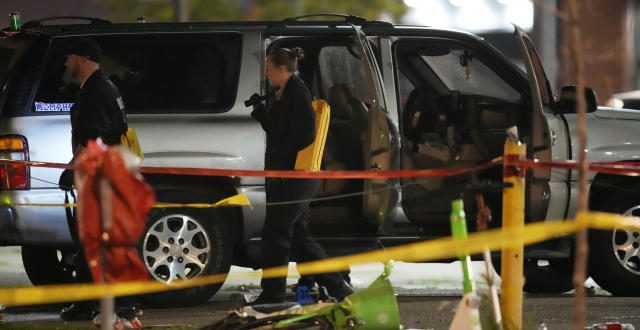Ten people were wounded in a mass shooting early Tuesday in Denver in an area where basketball fans had been celebrating the Nuggets first NBA title win, police said, and a suspect was taken into custody.
The shooting happened about 12:30 a.m. — about 3 1/2 hours after the game — and three of the injured were in critical condition, the Denver Police Department said in a statement. The suspect, a man, was one of the seven people who suffered injuries believed to be non-life-threatening.
The shooting happened about a mile from Ball Arena, where the Nuggets defeated the Miami Heat on Monday night.
“As far as what led up to this altercation that resulted in the shots being fired, that’s still under investigation at this time,” police spokesperson Doug Schepman said. “It did occur in the area where we had largest gathering of folks celebrating during the night.”
The area was taped off and evidence markers were at the scene.
A small crowd was in the area at the time of the shooting, he said, but had “diminished quite a bit at that point.” He said the shooting was in an area where a lot of people might have come out of bars after the game.
Police were interviewing witnesses and Schepman described the ongoing investigation “expansive.”
The violence is among at least 291 mass shootings in the U.S. so far this year in which four or more people were shot, excluding the shooter, according to the Gun Violence Archive.
Mass shootings account for the vast majority of mass killings, though there are examples where the perpetrator used knives or other weapons as well.
Experts point to a few contributing factors: a general increase in all types of gun violence in recent years; the proliferation of firearms amid lax gun laws; the effects of the coronavirus pandemic, including the stress of long months in quarantine; a political
climate unable or unwilling to change the status quo in meaningful ways; and an increased emphasis on violence in U.S. culture.
Such explanations are little comfort not only to the families ripped apart by the killings but to Americans everywhere who are reeling from the cascading, collective trauma of mass violence.
This year’s killings have happened in different ways, from family and neighborhood disputes to school and workplace shootings to explosions of gunfire in public spaces. They’ve taken place in rural as well as urban settings. Sometimes people knew their killers; sometimes they did not.
The bloodbaths are defined by the FBI as mass killings when the events involve four or more fatalities within 24 hours, not including the perpetrator.
Contributing to 2023′s steady drumbeat of death: the grisly murder-suicide in Utah that left five children, their parents and their grandmother dead just days into the new year; the fatal shooting of six people, including three 9-year-old children, at an elementary school in Nashville; back-to-back rampages in California at dance studios and mushroom farms; and the mall shooting in Allen, Texas, last month, when authorities say a gunman stepped out of a car and immediately started firing at people.
Yet while these tragic events garner an outsize amount of attention in the news media and the public’s mind, they represent only a tiny fraction of overall gun deaths.
Far more frequent are fatal shootings involving fewer than four people and deaths from domestic violence. And then there are the suicides, which make up more than half of the 14,000 gun deaths so far this year, according to the Gun Violence Archive, which monitors news media and police reports to compile data.
Still, mass killings spark the deepest fear in most people’s hearts.
“People around the country all send their kids to schools — and they worry about if they send their kid to school, are they going to get shot?” said Daniel Webster, a professor at the Johns Hopkins Center for Gun Violence Solutions.
The fact is, though they are less common than other gun deaths, the mass killings keep happening — 20 years after Columbine, 10 years after Sandy Hook, five years after Las Vegas, and less than one year after massacres at a supermarket in Buffalo, New York, and an elementary school in Uvalde, Texas.
People who study such violence are also perplexed by the sustained pace of the brutality.
“We have plenty of examples of things that seem to be at the breaking point in this country,” said Katherine Schweit, a former FBI executive who created the agency’s active shooter protocol after Sandy Hook. “When I was asked to work on this in 2013, I didn’t ever imagine 10 years later I’d still be working on the same thing.”

 صراط عشق صراط عشق
صراط عشق صراط عشق



